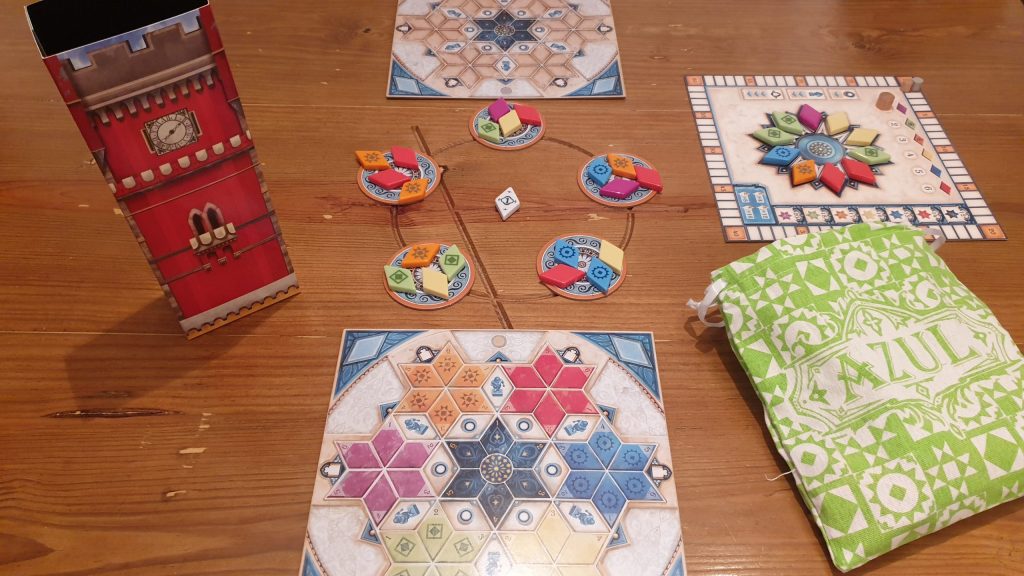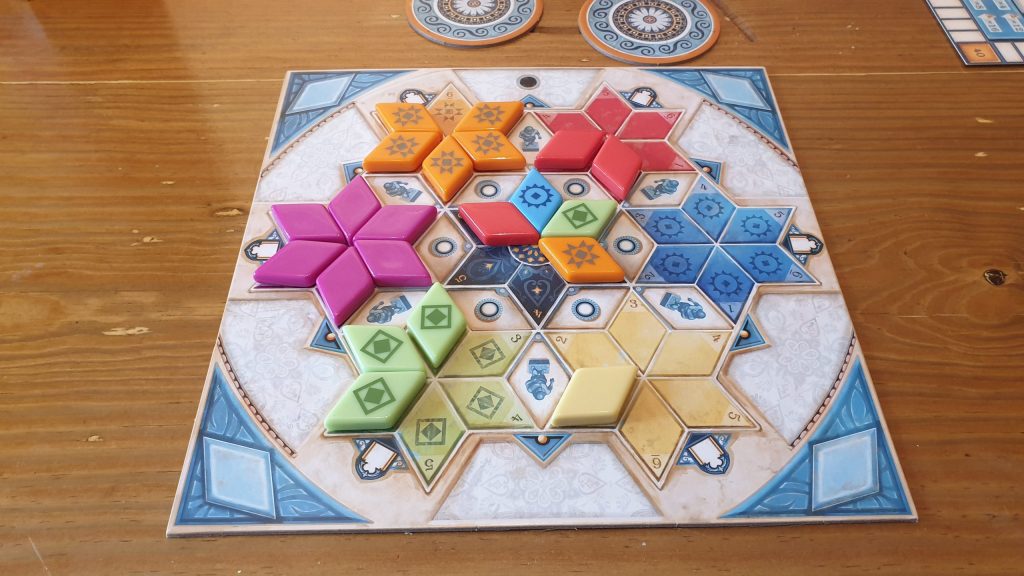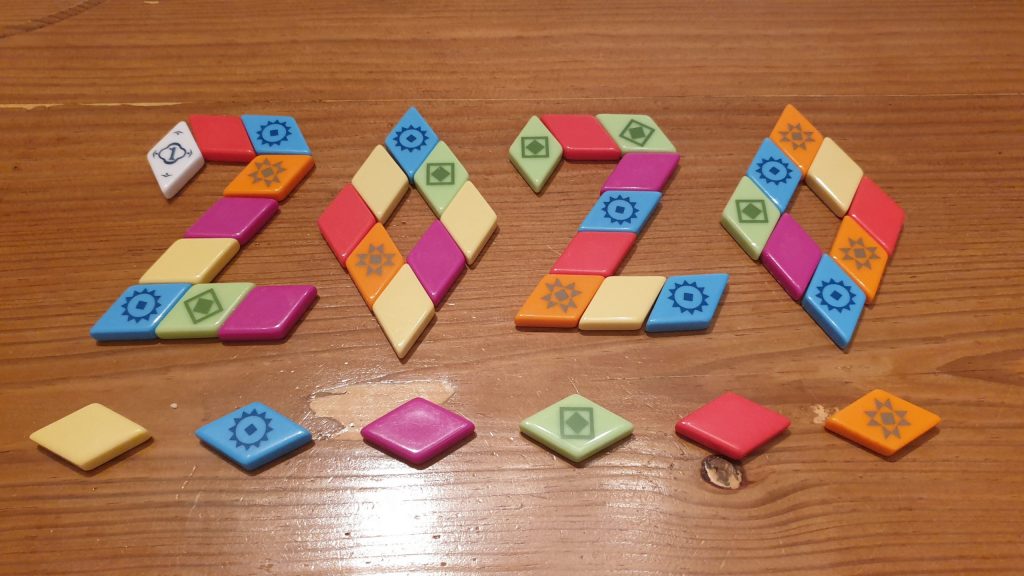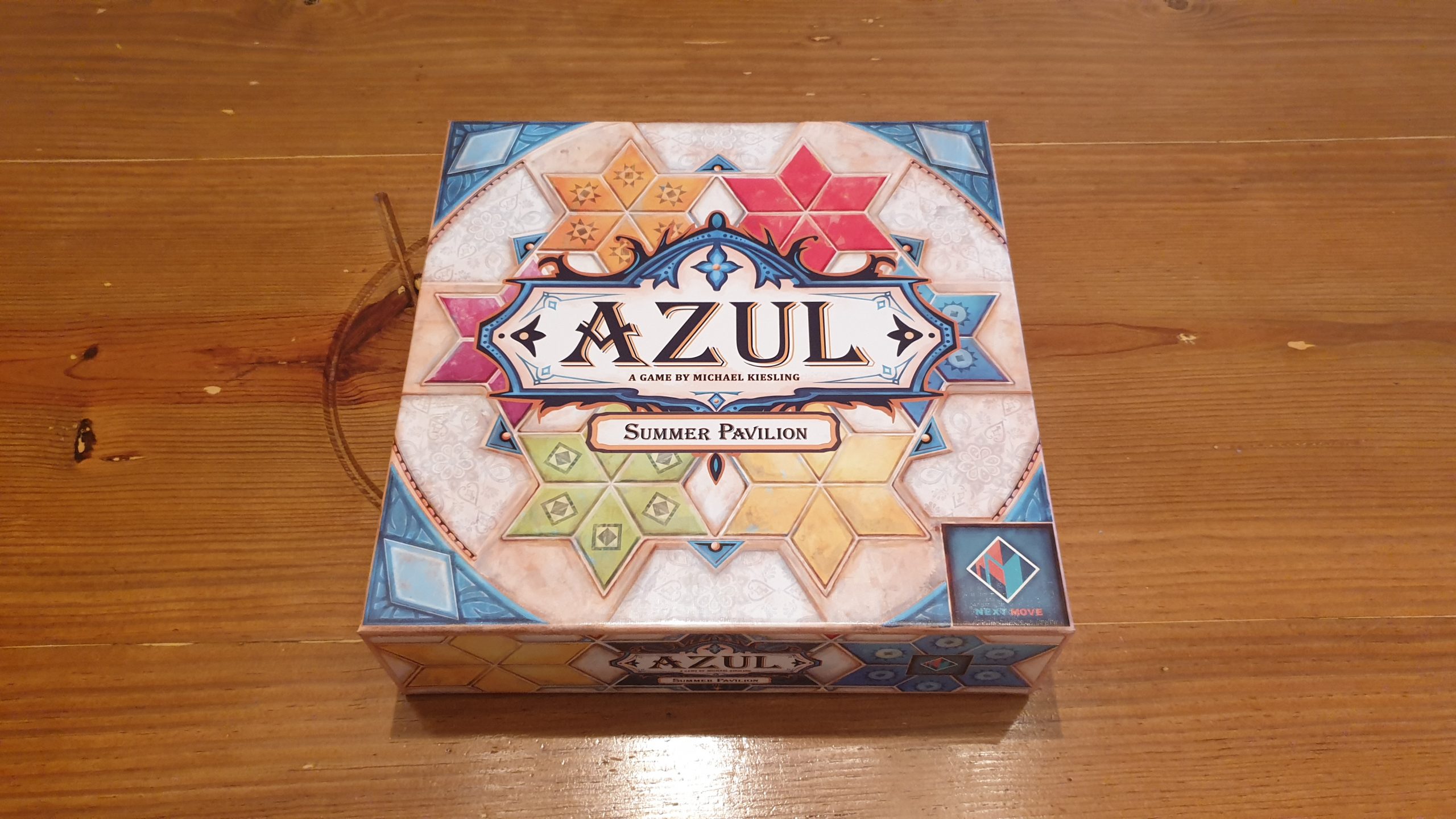Azul Summer Pavilion is the third installment of the abstract strategy, tile based series from publisher Next Move Games. Designed by Michael Kiesling, with artwork from Chris Quilliams, the game once again sees 2 – 4 players collecting tiles. This time the Portugese King is wanting a summer pavilion for the royal family, and squares aren’t going to cut it. For around 30 minutes artisans will take tiles, spend them to build and hopefully not waste any! Will this third Azul title equal the quality of the others? Let’s find out!
Played across six rounds, players will perform phases of taking tiles and placing tiles. Points are scored throughout the game in the placing phase, with a good amount of potential bonus points available at the end. Players boards feature six coloured stars and a central wild star, though on the reverse side variant the 6 coloured stars don’t have fixed locations. Filling stars is the way to gain points, making sure not to waste tiles.
At the start of Azul Summer Pavilion players choose as a group which side of the boards to use. The round marker starts on round one, indicating purple is wild. All of the diamond shaped tiles, apart form the first player tile, are tipped into the bag. A number of factory tiles are put in the middle of the table, each filled randomly with 4 tiles from the bag. The number of factories is dependant on the player count, for example at 2 players 5 are used. Finally, the spaces for tiles on the scoreboard are filled from the bag and the empty discard tower is put within reach.
During the taking phase players, in turn, take the tiles of one colour from either a factory or the middle. If taking from a factory unclaimed tiles left on it are pushed into the middle. If you are the first to take from the middle you will gain the first player marker, but also lose as many points as tiles taken. The twist is that at any point if there are any tiles of the wild colour at the location the player must also take 1 wild colour tile. In addition, players cannot choose to take the wild colour – unless otherwise unable to go. Play continues like this until every tile is taken. Note, unlike previous Azul games tiles are not instantly placed onto your player board.

Starting with the player with the first player marker players now take it in turns to add their claimed tiles onto their player board. Players are able to use a combination of a specific colour and the wild colour to do this. Each star has valued diamond spaces, numbered 1 – 6. For example, to place a tile onto the red 2 space, the player could use 2 red tiles or 1 red and 1 wild tile – with the wild colour indicated by the round. One of the used tiles is placed onto the player board, with the rest spent being discarded into the tower.
Every placed tile scores points. If there are none adjacent it is a simple 1 point. When a tile is placed adjacent to another it scores as many as it is connected to. For example, if a player had previously placed orange 1 and 2, placing orange 3 would mean 3 are connected for 3 points. Between rounds players can save up to 4 tiles. Any over this, or all at the end of the game, lose 1 point – with the tiles discarded into the tower.
There are three symbols that can be surrounded on the player board. When a player manages to surround a pillar, statue, or window they get to take tiles from the scoreboard. The amount of tiles depends on which symbol is surrounded, ranging from 1 – 3 tiles. This can allow a player to somewhat combo towards placing a higher number or scoring a lot of points in one round. These tiles are usable by the player in that placement phase. The empty spaces are then refilled from the bag, before the next player has their placement turn.
The next round then starts with a different colour becoming wild, and the player with the first player marker starting the round off by refilling the factories. Once the final round is over there is some bonus scoring to be awarded. For each completed star players score points, from 12 for completing the wild star, which must have one tile of each colour, through to 20 points for completing the purple star. Points are also awarded to players that have managed to cover all of the 1s, 2s, 3s, or 4s on their player board. At this point the artisan with the most points wins!

The main attraction for people wandering past are the glorious tiles. While there has been a departure from squares, and they are slightly thinner, the same solid feeling plastic tiles return. The vibrant colours work well. Though, as with the previous Azuls, it would have been a nice touch for all the colours to have a unique pattern on them – with some colours having no pattern on them at all. The player boards and the factory tiles work well and match the high quality Next Move is known for.
A few other common Azul title complaints remain. The main board is thin card, not being as robust as the player boards. It might be used less but it is still not the same quality. The player markers are fine, still they don’t properly fit on the score tracker alongside each other. This becomes less of a problem as players scores differ but at the start of the game is a tad irritating. Next Move has taken one solid step in the right direction with Azul Summer Pavilion, the discard tile tower has a sticker to reinforce the base. Progress has been made, and it does look striking on the table.
The selection mechanics are simple to pick up if you’ve played either of the other Azul titles. The additional caveats of when and how players obtain the wild colour for the round has tripped a few new players up. There was somewhat of an elegance to the simplicity of taking all of one colour and sliding the rest. Having this rule does change the dynamic of taking tiles though, and this leads to an impact on players’ choices.

At some point in the game the colour of tiles you need to complete a star is going to be harder to acquire. Not only are you yourself dwindling the supply by placing them but for one round they will be wild. All players will be unable to just take them, plus there is the temptation to use them as wild.
As players no longer instantly use tiles when they are taken, there is a double layer of choice available. Trying to take a set of one colour is a choice in one phase but how to utilize them is the bigger one in the next phase. You can split the set into smaller amounts. Place some perfectly to trigger bonus tiles via surrounding a board feature. There is even the viable option of holding onto them for the next round when they become wild. The ability to rest and not take tiles may be gone (present in Azul Stained Glass of Sintra). Still players have many ways to use tile and avoid negative points, with ample choice at each stage.
The core gameplay of the series isn’t hard to find in Azul Summer Pavilion. Players draw tiles in the same way, with a minor twist. Points are again earnt from placement, though quite how is unique and a different approach from the original. This creates a different puzzle from the other Azul titles. It may not be a big enough step for some to own more than one Azul, though the amount of choices available does at least elevate the experience. Nevertheless, if you don’t own another, Azul Summer Pavilion is a great game to add to your collection!
(Editor’s Note: Azul Summer Pavilion was provided to us by Asmodee for the review. The game is currently available from local board game stores, find your local store here.)

